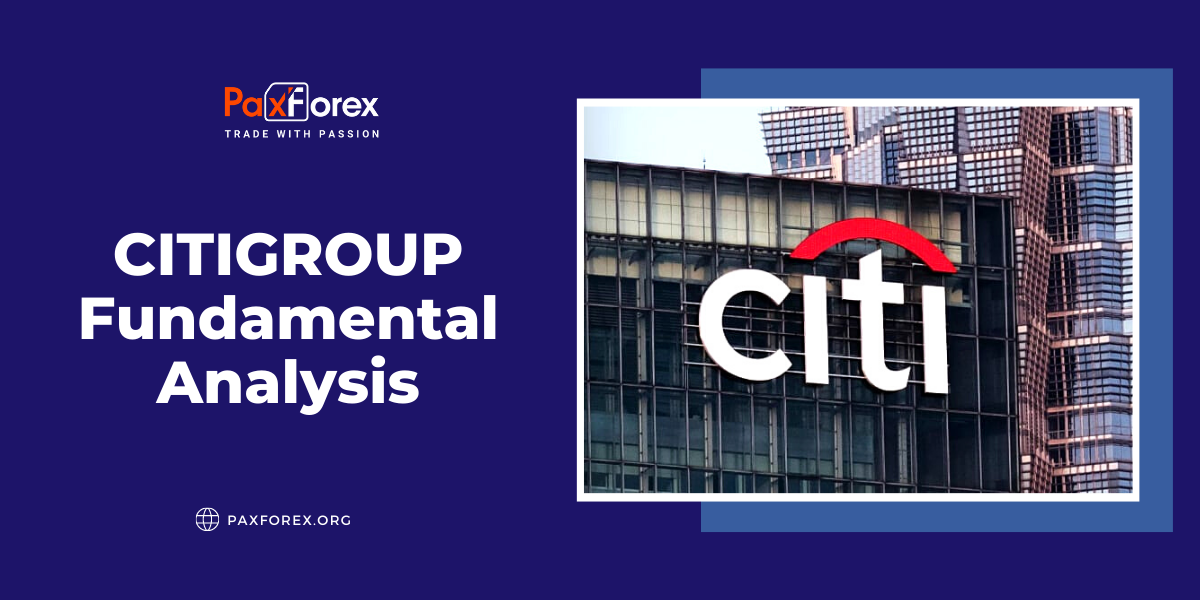
Source: PaxForex Premium Analytics Portal, Fundamental Insight
Citigroup held its long-awaited Investor Day, detailing its long-term strategic vision for getting the faltering bank back on track. Unfortunately, for investors who had hoped it would catalyze in the short term, Investor Day was not impressive enough. The bank has set financial goals that leave much to be desired and may take some time to achieve. In addition, it looks like it will take several years for the bank to address some regulatory issues and upgrade its technology.
At Investor Day, experts and analysts were waiting for long-term financial indicators. Chief among them was return on tangible total capital (ROTCE), which measures how much profit a bank made on equity, not including goodwill, intangibles, and preferred stock. Citigroup's ROTCE has struggled to keep up in recent years. Between 2017 and 2021, Citigroup's ROTCE average was 10.2%, compared to a similar average of about 13%.
At Investor Day, Citigroup said it expects ROTCE to be 11% to 12% over the medium term, which is the next three to five years. Everyone was hoping for higher numbers, as it seems unlikely that this target would close the gap with similar companies that have set much higher mid-to long-term ROTCE numbers.
There is a slight discrepancy in the timing for each bank, but again Citigroup hardly looks like it is closing the gap - if anything, the gap could widen. Even for those banks that had longer-term goals, Morgan Stanley has already reached 20% ROTCE in 2021, and Wells Fargo is operating under an asset limit that limits balance sheet growth, which is probably the most punitive regulatory ruling in the entire banking sector. If the restriction is lifted in the next year or two, Wells Fargo could improve its financial performance.
Another point is that Citigroup has also disclosed expected revenue growth rates in various business units, which will drive its ROTCE target of 11%-12%.
The bank is projecting compound annual growth rates in every division except markets and banking in the high single-digit percentage range, with asset management having the potential to achieve compound annual growth in the low tens of percent range. Investors had hoped that perhaps Citigroup was underestimating its ROTCE targets intending to outperform and raise them - and perhaps it is - but these earnings growth ratios don't seem conservative.
The issue is that Citigroup will create some revenue holes by selling all of its international consumer banking divisions, especially as it relates to Banamex in Mexico. In addition, total expenses are up 9% in 2021, and this year, if you exclude expenses related to asset sales in Asia, they will rise another 7% or 8%. Management has not claimed that fixing regulatory problems and upgrading information and technical systems will be an easy path, but the path certainly appears to be longer and more costly than everyone assumed.
The one positive aspect of Investor Day is that the goals detailed by management at least seem realistic, even if investors were hoping for more. Longtime bank analyst and Citigroup critic Mike Mayo even said that he thought he had never heard Citigroup use the words "failure" and "underperformance" more often than at Investor Day. Management also presented a full set of key performance indicators (KPIs) so that investors and analysts could track the company's progress and hold management accountable.
Many, of course, are disappointed with the ROTCE targets and may recognize that the bullish case for Citigroup is likely to take much longer and may not have as much upside potential as originally thought. Nonetheless, Citigroup may have some near-term upside potential, mainly because it trades at just 75% of book value, which is essentially a measure of the bank's net worth.
Despite the problems, given Citigroup's unique global scale and the high potential of some of its divisions, the bank should hardly be trading at a discount to book value (JPMorgan and Bank of America recently traded at about 200% of TBV). Investors gave the bank this valuation solely as a rebuke after so many broken promises and many, many years of underperformance.
Perhaps shareholders will come to their senses a bit from the fact that management has taken responsibility and developed a very clear plan of action.
As long as the price is below the 58.00 level, follow the recommendations below:
- Time frame: D1
- Recommendation: short position
- Entry point: 55.86
- Take Profit 1: 54.00
- Take Profit 2: 50.00
Alternative scenario:
If the level of 58.00 is broken-out, follow the recommendations below:
- Time frame: D1
- Recommendation: long position
- Entry point: 58.00
- Take Profit 1: 63.00
- Take Profit 2: 69.00













